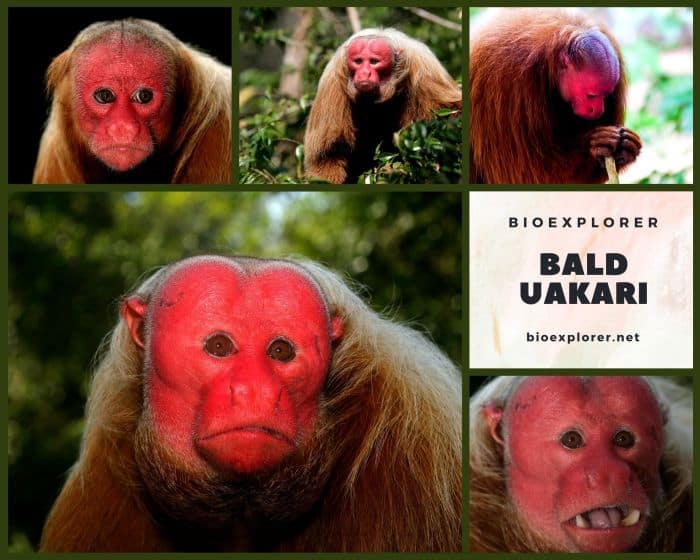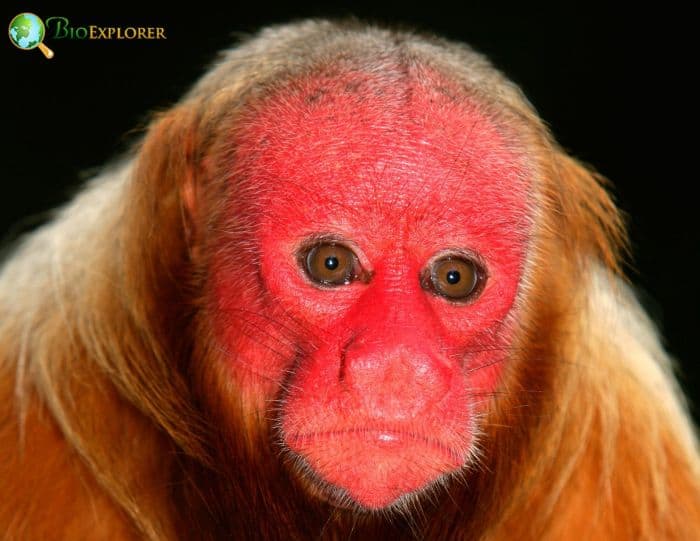
| Animalia | Primates | Pitheciidae | Cacajao | Cacajao calvus |
Deep in the flooded forests of the Amazon lives one of the rainforest’s most distinctive yet least-known inhabitants – the bald uakari monkey (Cacajao calvus).
With its vivid crimson face and almost entirely hairless head, the aptly named bald uakari cuts a striking figure as it bounds through the high treetops of its watery habitat. Yet beyond these curiosities, the species remains shrouded in mystery for most people outside primatology circles.
This arboreal primate survives and thrives in an environment that transforms dramatically with the annual rise and fall of the Amazon’s floodwaters. As we’ll explore, the bald uakari exhibits some fascinating evolutionary adaptations to this dynamic landscape – particularly as a seed predator able to exploit the forest’s seasonal bounty of fruits.
But its specialized niche and remote flooded forest home now render the uakari vulnerable as human encroachment, and deforestation pressures escalate across the Amazon.
This article delves into the biology, behavior, and conservation status of Amazonia’s charismatic crimson-faced monkey – the little-known world of the extraordinary bald uakari.


- Common Name: Bald Uacari
- Taxonomy Classification Year: 1847
- Monkey Size: 36 to 57 cm (14.17 to 22.44 inches)
- Skin Color(s): Orange, brown, red
- Habitat: Rainforest
- Diet: Herbivorous (frugivorous)
- Native Countries: Brazil, Peru, Colombia
Bald Uacari Distribution
What is the Bald Uakari Monkey?
Let’s examine what defines these distinctive primates, including their telling physical features and how scientists classify them.
Physical Description and Traits
The bald uakari (species name: Cacajao calvus) represents a New World Monkey characterized by several defining traits:
- A very short tail less than half the length of its body and head combined.
- A completely bald head the origin of its common name.
- Long, shaggy coat ranging in tone from white to red.
- Most famously a bright crimson red face lacking skin pigments.
Weighing between 2.75 and 3.45 kg on average, these compact monkeys have head-body lengths of 45.6 cm in males and 44 cm in females. Due to extensive blood vessels under the facial tissue, their faces flush an eye-catching scarlet hue.
![]()
Taxonomy and Subspecies
Taxonomists currently recognize 4 distinct subspecies of the bald uakari, all of which they designate as vulnerable:
- White bald uakari Cacajao calvus calvus.
- Ucayali bald uakari Cacajao calvus ucayalii.
- Red bald uakari Cacajao calvus rubicundus.
- Novae’s bald uakari Cacajao calvus novaesi.
These subspecies carry the same distinctive attributes of the bald uakari but differ somewhat in coat coloration and geographic distribution across the western Amazon.
![]()
Bald uakari Evolutionary History
While many aspects of their biology remain poorly understood, insights into the bald uakari’s evolutionary past help show how they developed into a unique flooded forest-dwelling primate.
- Scientists once hypothesized the two modern uakari species the bald uakari and the black-headed uakari (Cacajao melanocephalus) diverged during the Pleistocene epoch as Amazonian habitat fragmentation isolated different populations. This presumed their shared ancestor already specialized in flooded forest environments.
- However, evidence indicates the black-headed uakari and its closer cousin, the Bearded Saki (Chiropotes), occupy drier terra firme forests. Genetic analysis also reveals the two uakari lineages split further back during the late Pliocene. This disproves the Pleistocene divergence theory.
- As such, some researchers propose an adaptation to flooded forests represents a more recent, derived trait likely evolving specifically in bald uakaris after they diverge from the ancestral form that gave rise to black-headed uakaris and bearded sakis. But much mystery still surrounds the origins of bald uakari.
Undoubtedly, though, these monkeys bear witness to evolutionary forces’ adaptive power as we continue exploring.
![]()
Bald Uakari Habitat and Behavior
We now examine key aspects of the bald uakari monkey’s habitat preferences, social behavior, feeding ecology, communication patterns, and daily life.
Flooded Forest Specialists?
The bald uakari inhabits seasonally flooded forests across a range centered in western Amazonia. However, an open debate persists around whether the species strictly specializes in this habitat niche.
- Many older sources describe bald uakaris as flooded forest obligates unable to persist outside the várzea forests undergoing annual heavy inundation cycles. However, an analysis of documented sightings found most observations occurred in terra firme forests. Several other records come from mixed habitats blending fractions of flooded and unflooded forests.
- This demonstrates a high degree of flexibility rather than narrow restriction to flooded habitats. The researchers, therefore, conclude bald uakaris primarily occupy unflooded forests, with the ability to utilize mixed forest mosaics.
- Recognition of this more generalized habitat use holds significance for accurately modeling the species’ population status and conservation needs.
![]()
Arboreal and Sociable
Suiting its forest niche, the bald uakari demonstrates distinctly arboreal proclivities, most of its time climbing and foraging high in the canopy.
- Seasonal flooding only amplifies this, forcing the monkeys to remain treetop-bound during parts of the year when waters inundate the forest floor.
- Bald uakaris are also highly social, living in cohesive groups from 5 to 100 individuals strong on average. The basic social structure centers around noisy, active multi-male/multi-female troops.
- As with many primates, bald uakari social dynamics conform to female philopatry where males disperse from their natal groups upon reaching maturity.
- This social fabric likely helps bald uakaris efficiently locate and exploit patchy food resources and offers a better defense against predators like raptors and jungle cats through cooperative mobbing.
Their frequent associations with mixed-species flocks of monkeys may also enhance foraging and anti-predator benefits. More on that; it’s interesting in a bit!
![]()
What Do Bald Uakaris Eat?

The bald uakari’s distinctive adaptations and habitat lend insight into its dietary habits and foraging strategies. This primate has evolved highly specialized anatomy to access encased forest seeds.
Its robust, chisel-like lower jaw and wide molars allow bald uakaris to gnaw open tough shells most other monkeys can’t penetrate. This grants exclusive access to the enclosed nutritious seeds – an invaluable key to thriving in the flooded forests.
However, bald uakaris only partially target these well-protected food items. Field studies of their diet composition found:
- 55.4% seeds preferred harder-shelled seeds when available.
- 38.9% fruit pulp and arils consumed more soft fruits in low fruiting periods.
- 5.6% other small amounts of flowers, leaves, insects, etc.
So, while reliant on seed predation, the bald uakari also shows a measure of dietary flexibility. When ripe fleshy fruits grow scarce, they shift to eating more pulp and soft fruits than otherwise.
This aligns with a broader understanding of physical tradeoffs between jaw strength and size in primates. The biomechanics of bald uakari jaws allow them to feed on seeds with shells up to a certain toughness threshold.
![]()
Bald Uakari Communication and Relations
Bald uakaris utilize various signaling and social interaction forms to coordinate group activities, claim resources, and select mates – essential functions for a highly social primate.
- Their signature vibrant red facial complexion plays a pivotal role.
- The flush signifies healthy blood oxygenation, serving as an honest indicator of fitness.
- Females likely choose males with the most vivid face coloring during the October to May breeding season.
Territorial defense also drives key communication behaviors, including:
- Vocalizations a variety of calls used, some denoting threats.
- Tail wagging common display to signal aggression.
- Piloerection erecting the body hair to appear larger.
These displays help bald uakari troops guard priority foraging areas and seasonally scarce resources. Their extreme sociality breeds familiarity, too, with research showing bald uakaris can contract malaria and other parasites at high rates from close-knit interactions. Overall, complex signaling and symbiotic relationships define bald uakari society.
![]()
Bald Uakari Conservation Status and Threats
Today’s precarious state of bald uakaris stems from the interwoven threats of hunting, habitat destruction, and disease – compounded by their specialized ecology.
Threatened Population Numbers
They are classified as vulnerable on the IUCN Red List; bald uakari populations declined over 30% in recent decades by most estimates. Their numbers continue trending downward in the face of mounting anthropogenic pressures.
Deforestation Impacts Vulnerable Habitat
- Cloistered in rapidly vanishing Amazonian flooded forests, Habitat Loss poses the gravest danger. Historical deforestation rates, logging, fragmentation, and fires constantly squeeze the landscape bald uakaris rely on.
- As industry penetrates deeper into the Amazon, the southern and eastern regions the monkeys inhabit grow ever more threatened. Canopy disruption from logging also disproportionately degrades the arboreal pathways they depend on.
![]()
Hunting Compounds Threats
- Hunting further jeopardizes bald uakaris. Their lowland forests abutting Amazon waterways offer easy access for tree-based hunters. Slow reproductive rates compound the issue, making it challenging for bald uakaris to rebound from even low off-take rates.
- Annual tropical deforestation between 1980-1990 averaged 15.4 million hectares destroyed each year.
- In 1997, the Amazon Basin saw the highest rate of rainforest destruction globally.
- Nearly 3% of the Amazon is now covered by protected status areas and reserves through conservation programs.
- Brazil’s environmental agency IBAMA getting assistance from the military to patrol and enforce against illegal logging and encroachment.
![]()
Conservation Challenges and Efforts
Conservationists advocate for expanded protected status and enforcement covering larger swaths of bald uakari habitat.
- Some promising inroads slow the tide, but progress remains modest.
- Basic research on uakari distributions and habitat use must also catch duplicates in protective initiatives.
- However, ongoing discoveries continue to illuminate this fascinating flooded forest specialist.
![]()
Bald Uakari Fun Facts
Explore fascinating insights into the bald uakari’s distinctive biology and behavior.
That Bright Red Face Indicates Health
- The bald uakari’s flushed red facial complexion comes from having extensive underlying blood vessels and a lack of protective melanin in the facial skin.
- This enables direct external visualization of blood oxygenation levels.
- As such, the reddish skin is an honest indicator of overall health status, which female bald uakaris likely use to select high-quality mates.
- Males with the most vibrant red faces tend to attract more mating opportunities from October to May each year during the breeding season.
![]()
Specialized Tough-Seed Predation
- The robust jaws and wide molars of bald uakaris allow them to exert high bite forces capable of easily opening hard-shelled fruits that no other monkey species can access.
- Their specialized craniodental anatomy grants bald uakaris exclusive access to the enclosed nutritious seeds.
- However, jaw strength mechanics limit just how tough the seeds are that bald uakaris can extract and eat.
- An upper limit threshold exists for seed protection hardness beyond which their chewing muscles cannot penetrate.
![]()
Flexible Diet Shifts with Resource Availability
- The composition of bald uakaris’ diverse diet changes in response to seasonal resource availability within their flooded forest habitats.
- When fleshy ripe fruits grow scarce, bald uakaris shift their feeding focus to consuming more soft pulp and arils to supplement seed predation.
- Their overall proportions of seeds versus fruit vary across the year, tracking overall production.
- So, while highly specialized in some capacities, bald uakaris also display dietary flexibility in the face of environmental fluctuations.
![]()
Roam Widely Within Small Ranges
- Bald uakaris roam relatively small home range territories of up to 600 hectares in total area.
- This aligns with expectations based on their body mass and social group sizes.
- However, within their domains, they log impressively long average daily travel distances of up to 4.8 kilometers likely reflecting the patchy distribution of ripe resources across flooded forests.
- Their seed-based diet also may require more range to meet nutritional needs.
![]()
Highly Social with Partner Species
- Highly social by nature, bald uakaris live in cohesive troops spanning an unusually broad range from 5 to 100 members.
- This compares to modal group sizes of 15-25 individuals for related pitheciid primates.
- Bald uakaris also frequently associate and form mixed-species foraging groups with woolly monkeys in particular.
- This interspecies bonding while feeding likely confers reciprocal anti-predator and resource access advantages for bald uakaris and their woolly monkey partners.
![]()
Remarkably Long-Lived
- Bald uakaris are exceptionally long-lived monkeys compared to similarly sized primate species.
- Wild and captive populations include individuals surviving over 30 years matching human longevity after accounting for bald uakaris’ faster growth rates.
- Such extreme lifespans attest to bald uakaris’ evolutionary pedigree thriving in flooded forest environments despite seasonal resource uncertainty.
![]()
Conclusion
The unique crimson-faced bald uakari remains an obscure denizen of South America’s increasingly imperiled flooded forests. Yet the diverse adaptations of this acrobatic flooded forest specialist offer a compelling window into evolution amid dynamic tropical ecosystems. Hopefully, a deeper understanding of the bald uakaris’ surprising flexibility alongside its vulnerability will inform much-needed conservation measures to ensure the monkeys retain their niche in Amazonia’s intricate web of life for ages.
Even as the shroud lifts on some of their secrets thanks to pioneering field studies, much work lies ahead to unravel further mysteries locked inside the social world, obscure habits, and genetic insights of Cacajao calvus.
But on one certainty, all experts agree: protecting more critical habitat will prove essential to guarding the bald uakari’s future so we can continue glimpsing into its captivating ways hidden away high in the Amazon Basin’s remote flooded forests.
![]()










